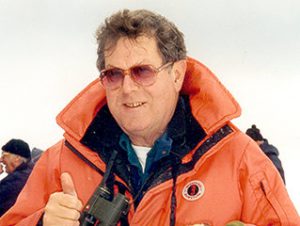It is with deep sadness that we mark the passing of John Splettstoesser – geologist, polar scientist, devoted Antarctican, and long-time friend of ALE – at age 82.
 John had a long work career as a geologist for the Minnesota Geological Survey, taught university geology and was a committed polar scientist. He spent eight field seasons in Antarctica (1960-61 to 1985-86), including two in the Ellsworth Mountains where he undertook pioneering geological fieldwork.
John had a long work career as a geologist for the Minnesota Geological Survey, taught university geology and was a committed polar scientist. He spent eight field seasons in Antarctica (1960-61 to 1985-86), including two in the Ellsworth Mountains where he undertook pioneering geological fieldwork.
The 1961 University of Minnesota expedition traversed the Sentinel and Heritage Ranges by snowmobiles and determined the upper stratigraphy of the Ellsworth Mountains. During the expedition, John and his colleague, Tom Bastien, climbed Mt Wyatt Earp (7776ft / 2370m), becoming the first people to climb a peak in the Sentinel Range. John returned in 1979-80, as part of a large helicopter supported field program to complete the first geologic survey of the Ellsworth Mountains. The results of their fieldwork were reported at a special symposium that was subsequently compiled in Geology and Paleontology of the Ellsworth Mountains.
Two Antarctic features commemorate John’s contributions to Antarctic geology. The Splettstoesser Glacier (S79° 12′ W84° 09′) is a 35-mile long glacier flowing ENE through the Heritage Range to the south of Founders Peaks and Anderson Massif. It was named by the University of Minnesota field party in 1961. Twenty years later, Splettstoesser Pass (S71° 39′ E167° 15′) was named for John’s role as the USARP field coordinator, during the 1981-82 Northern International Victoria Project.
John became involved in Antarctic tourism in the 1980’s, lecturing on board the early tourist vessels. His explanations on how Antarctica was formed, and how ice shaped the Antarctic landscape, as well as his humour and generous nature captivated guests and expedition staff alike. Over the years he accompanied more than 100 cruises to Antarctica and most of the sub-Antarctic islands, a 65-day circumnavigation cruise of Antarctica in 1996-97, as well as 45 cruises to the Arctic and sub-Arctic.
According Denise Landau, former IAATO Executive Director, ‘John was the glue that held more polar information together than most anyone around the world. He stored facts, figures, and stories like no one else I ever met and was always willing to share.’ John assisted IAATO with many school and student requests, providing informative answers ‘peppered with his trademark self-depreciating humour.’
He also worked as an advisor to IAATO, attending Antarctic Treaty Consultative Meetings and other meetings as needed. He believed that well managed tourism could be successful and helped craft numerous policy papers on minimizing environmental impacts in Antarctica. These have formed the basis for tourism guidelines in many remote regions around the world.
Spletts – as he was known to friends – remained a devoted and active Antarctican all his life: writing, lecturing and travelling to Antarctica until relatively recently. He was a committed member of the American Polar Society (APS), an organization that links scientists, explorers and enthusiasts around the world. He joined the Society in 1963 and served as President, Chairman, conference organizer, editor and anything else the APS needed to make the organization successful over the years. His articles, editorials and perspectives in the Polar Times were a driving force for the magazine production.
The polar regions have always attracted larger than life characters and John certainly holds his place amongst the best. According to Landau, ‘If anyone could have made Gondwana reunite, it would have been John Splettstoeser…His work in both the Arctic and Antarctic, with IAATO, the US Antarctic Program, Geological Survey, Universities, American Polar Society and the Antarctican Society for over 55 years truly grants him a place in the Holocene.’
We will sorely miss John with his endless optimism and humour; a great friend, colleague and huge resource.
More information on John Splettstoeser is available on the American Polar Society website.





